#bird watching anglesey
Text
Isle of Anglesey, Wales, UK...






#nature#hiking#wales#welsh#anglesey#united kingdom#great britain#britain#british isles#sunset#bird watching#puffins#travel#european travel#europe travel#beaches#rocky coast#lighthouse#lighthouses#irish sea#islands#ruins#castle#medieval castle
4 notes
·
View notes
Text
Shipwrecks, puffins and chip shops

It’s been a long day. My feet hurt. My legs hurt. Ominously, the achilles tendon that flared up while doing a charity run last year has flared up once again. I’ll have to be careful over the coming days and weeks.
So what did we do today?
We made our way to the north-eastern coast of Anglesey this morning, and did a circular walk from Moelfre, taking us first to the remains of an iron age village at Dyn Lligwy, and then on to a memorial where the “Royal Charter” wrecked with the loss of over four hundred lives in the 1800s.
In the afternoon we visited Beaumaris once again - this time to get aboard a sight-seeing boat that would take us out to “Puffin Island”. If you’ve never seen a puffin, they are a curious looking bird in the Awk family - with a short, solid body, small wings, and a distinctly un-aerodynamic shape. They are also quite rare - only inhabiting a few coastal islands around the United Kingdom.
While travelling out to the nature reserve the puffins have settled on in recent decades, we heard about the history of the island, and the lifecycle of the various birds that inhabit it. Some of the stories beggar belief - from a shipwreck landing rats on the island that the RAF had to eventually bomb with rat poison to wipe out, to an idiot landing a number of rabbits on the island - which proliferated into tens of thousands.
The puffins were unexpectedly wonderful. When landing they try to hover - only they can’t - so invariably crash every time they try to land. I watched one almost land wonderfully - only to completely lose control on final approach and fall head-first into the lapping waves below. When it bobbed up you could almost hear it spluttering “I’m fine!, I’m fine!”…
On our return we wandered along the sea-front at Beaumaris and picked out a popular-looking hotel to find some refreshment. While my other half found a table, I wandered in to find the bar.
Oh my word.
I’m not quite sure how I might describe the hotel. I have a good friend that’s a wonderful script-writer - all I could think about afterwards was that she would have thought she had hit gold. Think Fawlty Towers, but on a bigger scale.
While waiting in the queue at the bar - which itself took some finding - an elderly gentleman behind be struck up conversations.
“You’re luck you were not here half an hour ago”.
I glanced at him, questioningly.
“There were six people in the queue half an hour ago, one person serving - slowly - then when somebody came to help, the other buggered off.”
I smiled.
He then turned to the next person in the queue behind him, and recounted the exact same story - that everybody in the queue and all the bar-staff had already heard.
While carrying my drinks away from the bar, I became quite annoyed - that so many people find no greater delight than complaining about anything and everything. So many people find fault, rather than empathy with those they complain about. Right wing conspiracy theorists cause the same frustrations. It’s always about “the man”, and failures perceived through rose-tinted “better in my day” glasses - so rarely empathy or understanding.
Anyway.
Enough with the negativity. I won’t be drawn into their world.
We bought chips on the way home from a traditional chip-shop in the next village to where we’re staying. The staff were friendly, the locals picking up orders were wonderful, and the food was amazing.
Tomorrow is… tomorrow. We’re really not sure how we might share our final day here. Perhaps the weather will decide for us. We’ll see.
6 notes
·
View notes
Text
Looking back on a week in amazing Anglesey and wonderful wider North Wales
Over the past week another trip outside of England for me this year among mountains centred on a beautiful island has allowed us to have a special wild adventure. It was a week of splendour, spectacle and thrilling experiences.
Bird and mammal wise we saw some of the finest sights UK wildlife has to offer, from being ensconced in the spectacular tern and gull colony of Cemlyn, seeing our first Arctic Terns this year and marveling at the many neat Sandwich Tern, also seeing Common Tern and Black-headed Gull with views of chicks enjoyed to watching in aw in the evening sunlight a Red Squirrel feed in the magical Newborough Forest an astonishing sight to ensure I’ve seen these divine mammals in England, Scotland and Wales this year. The distinctive smell, consuming noise and fantastic sight of seabird colonies dominated the week, with charismatic and eyecatching Puffins, Guillemots, Razorbills, Kittiwakes, Fulmars, Shag and more enjoyed between two visits to the fabulous RSPB South Stack and a brilliant boat trip around Puffin Island. Days full of glee. Staggeringly intimate views of Grey Seal on the boat trip and fine evening views of Manx Shearwater gliding across the sea at Cemaes where we stayed and Llanbadrig and some seen at Cemlyn on the last morning were other moments of nautical wild bliss. It was phenomenal and valuable to get such splendid views of Black Guillemots again across the week, a favourite bird of mine we don’t get at home which I am having a top year for. Anglesey is synonymous with Choughs and at South Stack, the Range and on a journey at one point we have had some sensational times seeing these red and black wonders exceptionally well. Their sharp call and breathtaking appearance has left me spellbound and filled my heart with joy. We also saw some at the Great Orme on a wider North Wales part of the trip.
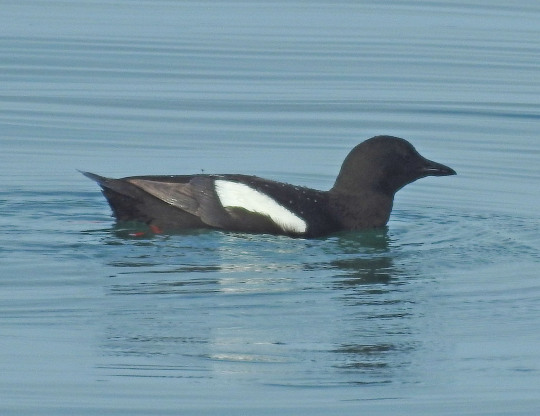
A Black Guillemot at Holyhead Fish Quay on Sunday evening

Chough at South Stack on Monday
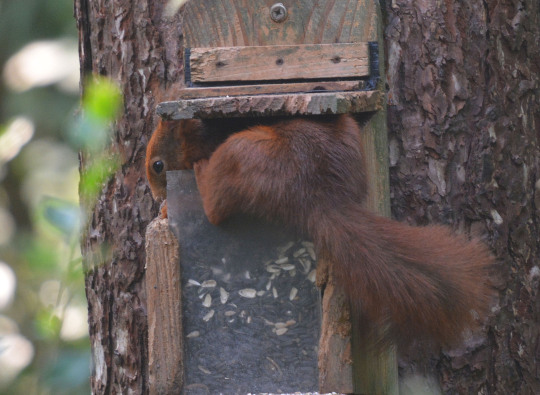
The Red Squirrel we saw at Newborough Forest
Adding further gloss and helping my bird year list become personally historic was my first sighting this year of a Little Ringed Plover on a wider jaunt to RSPB Conwy. Other standout birds of the trip included Shelduck, Oystercatcher, Red-breasted Merganser, Gannet including on Ynys Badrig, Herring Gull, House Martins, Swallow, Whitethroat, Bullfinch, Pied Wagtail, Wheatear, Rooks heard and seen well from the lovely cottage we stayed in, Raven, Jay and Buzzard. Crossing Eryri on Wednesday on the way back from Conwy seeing Grey Wagtail at Betws-y-Coed, Hen Harriers and Goosander and Common Sandpiper at Llyn Ogwen added some top species to the week.
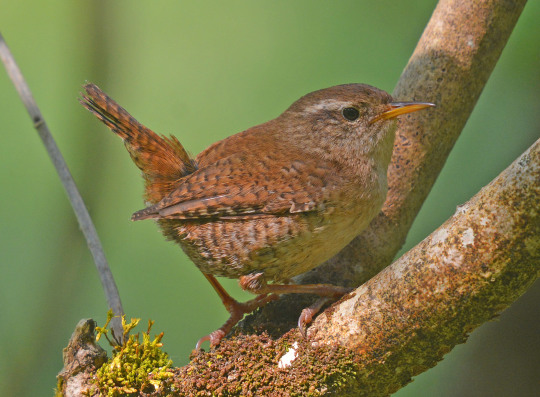
Wren at Nant-y-Pandy on Thursday which was a joy to see too.
In spring/summer holidays geared towards birds it’s always nice to see some insects during it and it occurred to me during the week we might be able to see Silver-studded Blues here, that we did at the Range by South Stack on Tuesday. Immersive moments watching this precious gem of a butterfly. In heatwave conditions as the week went on Ringlet, Dark Green Fritillary, Small Skipper and Common Grayling at the Great Orme probably of the sub species Hipparchia semele emerging early and unique to this site were ones we saw for the first time this year as I sailed into seeing summer butterfly species, with Meadow Brown, Common Blue, Large Skipper, Small Tortoiseshell and oh so many Red Admirals also seen. Hummingbird hawk-moth, Silver Y, my first Six-spot Burnets of the year seen well, Straw Dot, Brown-silver Line and Grass Veneers made it a marvellous moth week too.
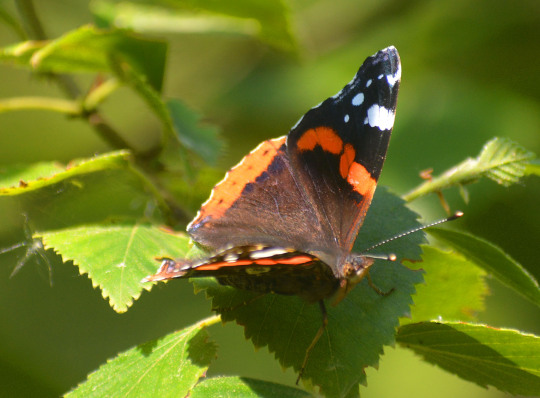
One of the Red Admirals seen this week at Newborough Forest
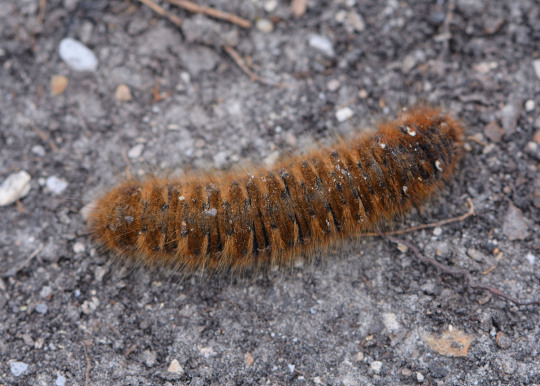
Caterpillars played their part too with a few seen, this of the Oak Eggar moth at South Stack.
As hoped we saw Four-spotted Chaser dragonflies, with a surprise Golden-ringed Dragonfly an exquisite moment in the trip at a stream at Nant-y-Pandy aka the Dingle and Southern Hawker also firsts for the year. Emperor, Broad-bodied Chaser as well as Blue-tailed, Common Blue and Azure Damselflies and Banded Demoiselle were pleasant to see too. It was also a top trip of beetles with many Swollen-thighed beetles and my first ever Chrysomela populi and Rose Chafer beetle seen.

Mating Azure Damselflies which was a strong memory of a hot and sunny time at Cors Ddyga on Thursday.

The Chrysomela populi, one of many we saw on a Newborough dune walk on Thursday.
It was a flower fest this week with massive species of my year seen such as my first alluring bee and pyramidal orchids of the year at RSPB Conwy and lots of sheep’s-bit. Marsh helleborine, early marsh orchid, purple sandwort, sea plantain and bright yellow-horned poppy were new flower species I was amazed to see. Thrift, sea and red campion, chamomile, wild carrot and cabbage, foxgloves, thyme, wall pennywort, bird’s-foot trefoil and rich English stonecrop seen consistently well were strong characteristic plants of the trip for me as many were when here two years ago. And on that note I could not forget the joy of seeing again at Valley Wetlands and Cors Ddyga RSPB reserves my star flower from 2021, excellent marsh cinquefoil.

One of the many RSPB Conwy bee orchids seen
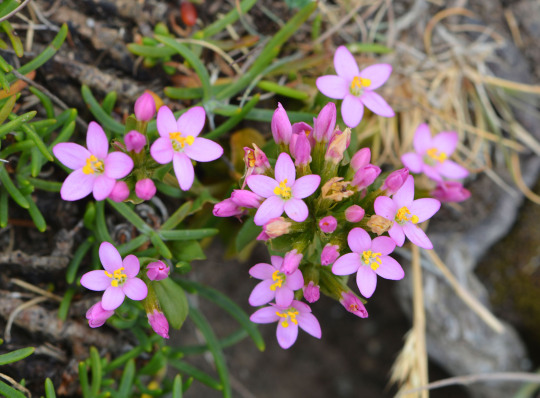
Centaury at South Stack, another key one this week.
The views were something else again; cliff, beach and dune coast, woodland, heath, meadow, lake and mountains. There were breathtaking moments observing stunning landscapes and being immersed in them on Friday riding the Great Orme cable cars at Llandudno and going three quarters of the way up Yr Wyddfa on the Snowdon Mountain Railway. I enjoyed stunning scenes of the sun going down over the water on evenings at Cemaes and Llanbadrig. It is such an aesthetically pleasing part of the world. What a week, so much covered and seen and so many glorious memories made. I love Anglesey and North Wales generally and I can’t wait to come back.

Looking across to South Stack from the Range on Tuesday
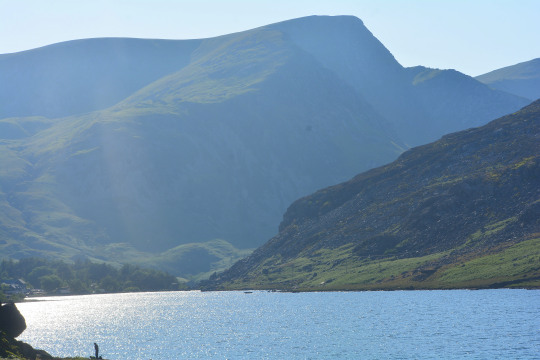
Llyn Ogwen on Wednesday
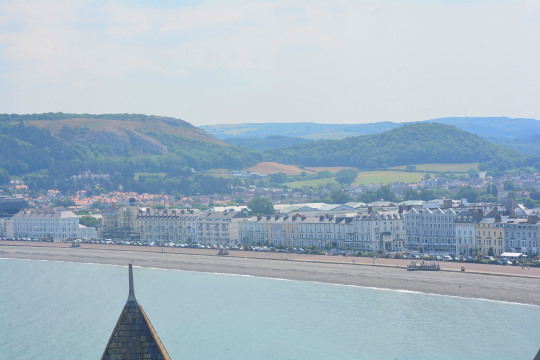
Llandudno on Friday

Grey Seal seen on the boat trip around Puffin Island on Tuesday.
#photography#birdwatching#birds#butterflies#uk#earth#nature#world#chough#black guillemot#grey seal#puffin#puffins#razorbill#guillemot#gannet#shag#red squirrel#bee orchid#little ringed plover#outdoors#sea#coast#island#anglesey#wales#north wales#holiday#june#2023
5 notes
·
View notes
Text
Birdwatching in the UK - Discover Rare Birds with the RSPB
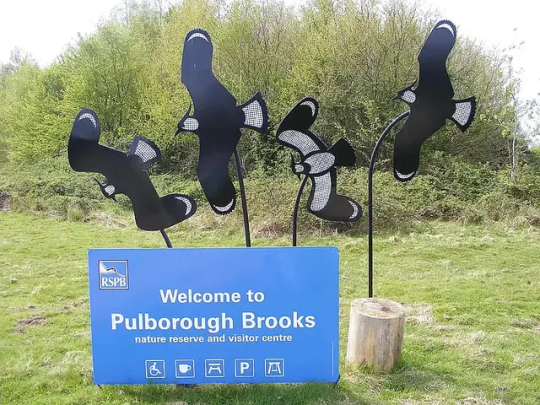
The Growing Popularity of Birdwatching in the UK
Birdwatching has become a popular activity for many people in the UK, and it's no surprise why. With its abundance of natural habitats and diverse bird species, the country offers an ideal environment to enjoy this pastime.
The Royal Society for the Protection of Birds (RSPB) is one organization that has been instrumental in promoting birdwatching across the UK.
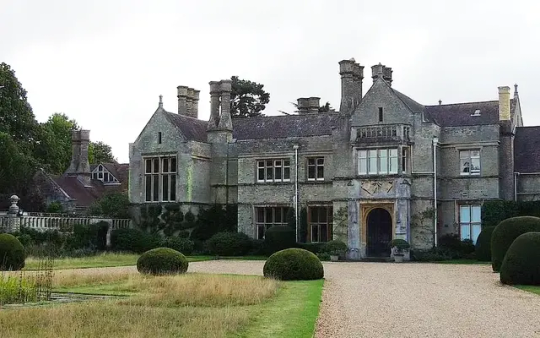
The Lodge, Sandy, Bedfordshire. Headquaters of the RSPB. Photo by Orangeaurochs. Flickr.
The RSPB and its Mission
The Royal Society for the Protection of Birds is a UK-based charitable organization that was founded in 1889.
Its primary mission is to promote and protect the welfare of wild birds and their habitats. It has grown into one of the largest wildlife conservation charities in Europe, with over 1.2 million members and supporters.
Milestones in RSPB's History
One of the key milestones in the history of RSPB was its successful campaign to ban the use of DDT, a toxic pesticide that led to a decline in bird populations during the mid-20th century.
The RSPB's efforts prompted governments around the world to take action against DDT and other harmful chemicals, leading to significant improvements in bird populations across many regions.

Starling Murmuration - RSPB Minsmere. Photo by Airwolfhound. Flickr.
Top Birdwatching Locations in the UK
Are you an avid birdwatcher? Then you're in luck! The RSPB offers a multitude of stunning birdwatching locations throughout the UK. Here are some of the best:
1. Minsmere: Located on the Suffolk coast, this reserve is home to over 100 breeding species and a variety of habitats such as reedbeds, woodland, and heathland.
2. Bempton Cliffs: Situated on the Yorkshire coast, this reserve boasts breath taking views of thousands of seabirds including puffins, gannets and kittiwakes.
3. Loch Garten: In Scotland's Cairngorms National Park lies this tranquil location known for its impressive highland scenery and resident ospreys which can be seen fishing in summer months.
4. Anglesey, Wales: There are several RSPB sites but the stand out one is the South Stack Cliffs Nature Reserve: boasting a home to over 4,000 species, including guillemots, puffins, choughs, and razorbills.
5. The Cairngorms, Scotland: Explore the Cairngorms and discover a range of rare and majestic wildlife including birds of prey. Keep an eye out for elusive creatures like the ptarmigan, siskin, and grey-footed woodpecker. And if you're lucky, you might even catch a glimpse of the UK's largest grouse species, the capercaillie.
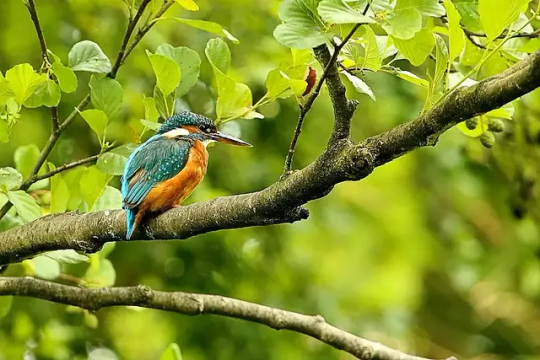
Kingfisher - RSPB Fowlmere. Photo by Airwolfhound. Flickr.
Bird species to look out for at RSPB sites
The Royal Society for the Protection of Birds has identified several bird species that visitors to their sites in the UK should keep an eye out for.
These birds are not only beautiful to look at but also play a vital role in maintaining the delicate balance of our ecosystems.
One such bird is the kingfisher, which can be found near water sources such as rivers and lakes. With its distinctive blue and orange plumage, it is easily recognisable and a joy to watch as it dives into the water to catch fish.
Another bird species worth keeping an eye out for is the puffin, which can be spotted at RSPB Bempton Cliffs in Yorkshire during breeding season. Their strikingly colourful beaks make them instantly recognisable and they are a favourite among birdwatchers.

Entrance Lodge, RSPB reserve, Sandy. Photo by Martyn Johnson. Wikimedia.
Getting Involved with the RSPB
The Royal Society for the Protection of Birds is a UK-based charity that works to protect birds and their habitats.
If you're interested in getting involved with this important conservation work, there are several ways to do so. One option is to become a member of the RSPB.
Membership Benefits
Membership benefits include receiving a quarterly magazine, free entry to over 170 nature reserves across the UK, and discounts on bird food and accessories. The membership also includes a welcome pack and a free gift for each new adult member.
Events and Volunteering
Another way to get involved with the RSPB is by attending one of their many events. The organization hosts talks, walks, and other activities that allow members of the public to learn more about birds and conservation efforts in general.
Additionally, volunteering with the RSPB can be an incredibly rewarding experience for those who want to make a hands-on difference in bird protection efforts.

A colony of puffins. Photo by Joxean Koret. Flickr.
Benefits of Birdwatching for Mental and Physical Health
Birdwatching has always been a popular hobby in the UK, and for good reason. Not only is it a great way to enjoy the outdoors, but it also comes with numerous mental and physical health benefits.
The Royal Society for the Protection of Birds reports that birdwatching can help reduce stress levels, improve our mood and even boost our immune system.
Studies have shown that spending time outdoors surrounded by nature can have a significant impact on our mental health and birdwatching is an excellent way to incorporate this into your life.
It allows us to disconnect from the stresses of daily life and be present in the moment, focusing on the beauty of these fascinating creatures. Watching birds can give us a sense of calmness and serenity, which promotes relaxation and reduces anxiety levels.
In addition to its positive effects on our mental wellbeing, birdwatching encourages people to walk outdoors and this provides numerous physical benefits.

red-breasted nuthatch. Photo by Matt MacGillivray. Flickr.
Embracing Birdwatching with the RSPB
In conclusion, birdwatching has become an increasingly popular hobby in the UK and offers a great way to connect with nature.
The Royal Society for the Protection of Birds is one of the leading organizations in the UK dedicated to conserving birds and their habitats.
By joining this organization as a member, you not only support their conservation efforts but also gain access to expert advice on birdwatching and to their sites.
Birdwatching can be enjoyed from anywhere, whether it's from your own backyard or out in nature reserves. With over 600 species of birds found in the UK, there's always something new to discover.
Observing these fascinating creatures can help us appreciate the diversity of life around us and develop a deeper understanding of our environment.
So why not give birdwatching a try? Whether you're just starting out or have years of experience, RSPB provides resources and guidance for all levels.
Sources: THX News, Wonderlust & RSPB.
Read the full article
#Birdconservationefforts#Birdwatchingevents#BirdwatchingintheUK#GettinginvolvedwithRSPB#JoinRSPBmembership#Mentalhealthbenefits#Physicalhealthadvantages#RSPBorganization#Topbirdwatchinglocations#UKbirdspecies
0 notes
Text
Things to do in north Wales
Things to do in north Wales
Easter is here, the sun is out and I’m getting this blog out the door early so I can head to the beach like you lot! Ok so, I’ve have compiled a list of the top 25 activities and adventures in north Wales, for you to experience during your Easter stay. There are so many amazing attractions and activities in north Wales, you don’t need to venture far in any given direction to find one or more of…
View On WordPress
#bass#bass fishing#beach#beach art#beachglass#berddgelert#biking#bird watching#bird watching anglesey#boat#bouldering#Caernarfon#Camoing#campervans#campfire#camping#camping anglesey#camping llyn#Camping Llyn Peninsula#Camping north wales#camping snowdonia#Carneddau#castles#celtic#chip shops anglesey#Christmas in north wlaes#Christmas jumpers#clean#cleanoceans#Climbing
1 note
·
View note
Text
Writer’s Month day 22 - house
This is actually based on a real place that I have visited twice, most recently last year: Holyhead Mountain Hut Circles on the Isle of Anglesey, Wales. The site is right next to South Stack lighthouse and an RSPB reserve (of the same name) and has amazing cliff top views across the Irish Sea. With so many people nearby watching the birds (including the now rare choughs) it was quite weird to leave the road and enter a place that was inhabited 2000 years ago. I recommend visiting if you are in the area, and if you time it right you might even see some puffins!
TW: Briefly describes what all parts of a butchered sheep was used for 2000 years ago. Perhaps not one for the squeamish.
-------
The choughs sang their rough call as they circled above the plough, the bulls making steady progress through the stony ground. Other choughs had already landed in the furrows, digging with their red legs and beaks into the churned soil, their jet black feathers shining in what little sunlight broke though the grey clouds.
The sheep penned in the remains of a century old hut bleated their displeasure, its stone walls bare of a roof, a perfect place to separate out the ewes too lame, sick, old or otherwise unlikely to survive the next year on this exposed hillside. They will be butchered first, their meat filling bellies for months as their skins are made into leather for clothes, shoes, bags and other equipment, or rubbed with their own brains to keep the fleece intact, warming beds and skin for years. The organs, sinews and bones have their own uses, no part of the animal is wasted. Any produce not used can be traded away inland, for metal, for vegetables too weak to survive the soil in this location, dyes for wool, anything not found, grown or hunted in this little patch of land at the end of the earth.
Salt and seaweed could be tasted on the wind, the blue-green-grey of the sea rising over the green grass and ferns that tipped over the edge of the nearby cliff. At sunset the water is lit up in gold and orange as the fire in the sky extinguishes itself in a watery grave, only to be reborn in the morning as it climbs over the hill opposite.
Three huts stood in a line between hill and sea, thick stone walls topped with thatched roofs pointing towards the sky. A well worn path trailed between them, towards the sea and up the hill, from coast to crown, connecting all the lands that belonged to the little farmstead.
The remains of other huts were just visible, their walls slowly taken over by grasses and bracken and heather. The homes of a single, unbroken line of one family. The past lived there, though they were slowly fading from existence.
The entrance of one was open, the leather flap that kept out the biting wind pinned to the interior, letting in what daylight there was. The inside was still gloomy, despite the open door and the flames that danced from the hearth in the center.
Fish, caught in a little boat accessed only by a precarious path down the rocky cliff, was cooking in the pot, the fire underneath spitting and popping, filling the hut with the unmistakable tang of wood smoke. A flat rock just outside the flames held a round loaf, slowly cooking in the nearby heat.
A loom sat by the door, colourful wool threads hanging from the half finished fabric, the browns of the earth, greens of the heather, the reds of rocks found elsewhere all adorning a small area of cloth. A spindle sat nearby, discarded for now, a half formed yarn trailing from a mass of grey fleece. Bone needles sat neatly in a little clay pot, roughly formed with zig zags and fingerprints impressed on its surface. Another bowl, larger but decorated in the same fashion, sat filled with flour next to a quern stone, today's effort of the daily grind.
Other tools lay scattered around, knives and sickles, spears and arrows, tools essential to survive, all carefully maintained to preserve their usefulness. Without them life would be even more difficult.
A meagre existence was eked out here, but at least it was a better life than those poor souls who toiled their whole life in the copper mine two days walk away. Even the gloomiest and coldest day on this hill top was better than the darkness and danger that lurked underground.
It was a harsh life, but it was home.
------
Whilst researching more about this site I came across this video which shows the site in 3d/virtual reality and shows a recreation of what it might have looked like when it was inhabited. For more information and photos visit this Megalithic Portal page or for visiting info this Cadw page.
#WritersMonth2021#writers month#My writing#writeblr#writers on tumblr#am writing#creative writing#writing#spilled ink#history#britain
2 notes
·
View notes
Text
HOW TO GET AN ACTIVE WEEKEND IN WALES AS A STUDENT
Description: If you have a free weekend from college, you should get the best out of it and go to Wales. It has a lot of things to offer, even for picky students.
If you don’t know where to go, then it is time to explore the UK. This stunning country has a lot of things to offer, so you will hardly get bored. Its diversity admires and evokes a wide range of positive emotions. And since all the regions are different and have their peculiarities, you should decide on a starting point of your journey. If you have turned to the essay helper online and cleared up your weekend to have enough time and energy for different activities, it is high time to go to Wales. You will be amazed by the number of interesting things you can do in this region. Cosmopolitan Cardiff itself is a great reason to go there.
Nonetheless, if you are going to make your weekend as active as possible, you shouldn’t limit yourself but go to venture further afield. Wales is a great choice if you need a change of scenery since its numerous attractions, gardens, parks, etc., will make your traveling experience unforgettable. So, where should you go and what places to visit in this stunning corner of the globe?
1. Snowdonia National Park
If you’ve got tired of the hustle and bustle of a big city, it is time to go to Snowdonia that represents a picturesque range of hills and mountains. The highest pick is more than 3,000 feet, and you can reach it by train. Before the pandemic, it was one of the most popular gateways in the UK, so it hosted about five million travelers yearly. If you are fond of legends, especially those connected with British kings, you will get a huge portion of new info. However, since you are interested in the active pastime, it is worth going hiking in the National Park, which covers about 1,500 miles. Besides, you can try your hand at horse riding and mountain biking.
2. Brecon Beacons National Park
It is considered one of the most picturesque parts of the region, so don’t forget to grab a camera with you to take beautiful pics. If you go to the west, you will run into the River Usk, while the east direction will take you to wild yet very cute ponies. The park can boast of mountains that are more than 1,000 feet higher and consist of red sandstone. The latter makes them resemble working beacons. The weekend can be enough to investigate numerous caves and enjoy wonderful waterfalls. Besides, you can go camping, canoe and sail there.
3. Devil’s Bridge
If you find yourself in Wales, make sure to visit this sightseeing that represents three bridges impressively stowed atop each other. The oldest one was created somewhere in the eleventh century, while the newest one was finished 120 years ago. This construction goes through the Rheidol Gorge 300 feet above the river. It is worth following the Falls Nature Trail till the end if you are physically fit. If you decide on such a journey, you will be able to walk through ancient woodlands and gardens. To get the best out of your traveling experience, it is worth turning to the write my paper for me service beforehand, so you will not worry about failed deadlines but enjoy your short vacation.
4. Conwy
If you decide to explore the north coast of the region, you should definitely pop in the small town of Conwy. You will be able to enjoy ancient architecture and get an amazing shopping experience. You will come across the self-named castle that dates back to the 13th century. Unfortunately, the epidemic has made people cancel all the fascinating events that draw people from the region.
5. Pembrokeshire Coast National Park
If you are fond of nature, and a dramatic coastline can give you a good portion of goosebumps, you should necessarily go to this gorgeous park. There is a special trail that you can explore to enjoy this wild paradise to the fullest. You will come upon cute villages with medieval walls, fishing harbors, and other attractions. Thus, if you are interested in creating interesting and unusual content for your web profiles, make sure to take a camera or a smartphone with an additional charging pack. You will hardly stop taking pics at every corner. Besides, if you want to stay in an unusual place, you can count on an old farm cottage or gypsy caravan. Well, you will not forget this weekend for sure if you decide on such a trip.
6. Anglesey
If you have a tight schedule in college and want to prolong your weekend at least for a day, it is worth reaching out to the nurse essay writing service to meet this challenge. You can spend this time exploring the Isle of Anglesey, separated from the mainland part of Wales by a strait. It can boast of numerous cute fishing villages, sandy beaches, and truly stunning South Stack Lighthouse. The latter is a good reason to come here by itself. You can go camping there to examine the whole territory and linked islands. For instance, Salt Island is one of the most suitable and comfortable spots for bird watching and relaxing.
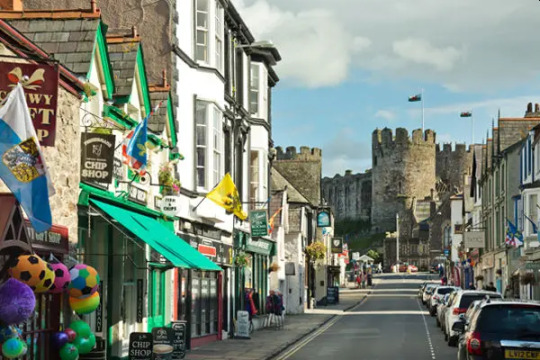
3 notes
·
View notes
Text
Britain’s best autumn wildlife spectacles
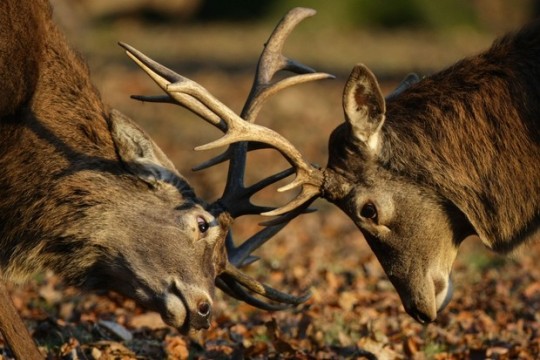
September is the month when autumn really takes hold, as hedgerows bustle with activity and the landscape starts changing. By October and November, autumn is in full swing, and with it comes a host of incredible wildlife spectacles.
Starling murmurations

The starlings flying over Brighton’s Old Pier at sunset Getty
Some of the most magnificent spectacles in nature’s calendar are the starling murmurations that grace our skies from autumn, peaking in late November and early December. Thousands of starlings can be seen taking flight and forming dark shapes, which rise, dip and turn in perfect unison. Sometimes these hypnotic clouds can be made up of over 100,000 starlings as hordes of new migrant birds continue to arrive in Britain each week. Early evening is the best time to view this soiree as starlings take flight to choose their night-time shelters. Malltraeth Marsh in Anglesey, RSPB Leighton Moss in Lancashire and Ham Wall in Somerset are all great places to watch the birds in action.
Foraging red squirrels

Red squirrels are busy foraging seeds and berries for their winter larder
In autumn, red squirrels are busy searching for tree seeds, fungi, berries, birds’ eggs and even sap to fatten them up for winter. They love hazelnuts but have trouble digesting acorns, unlike grey squirrels, who love them. Red squirrels like to look after their teeth by gnawing on pieces of dead deer antler, which are full of calcium. Squirrels have an exceptionally good sense of smell. They can find buried food underneath a foot of snow and know if a nut is rotten without opening it.
Salmon run
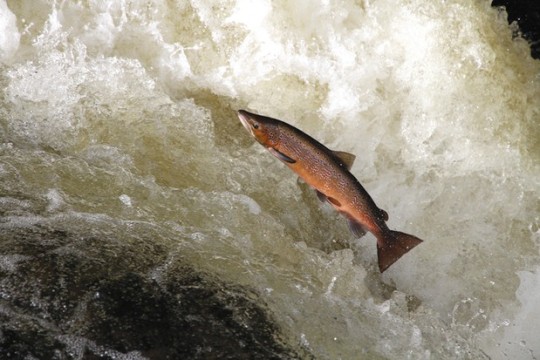
Come autumn, the aim of the salmon is simple – to reach spawning grounds in the higher reaches of clean, fast-flowing rivers where they themselves were born. This is perfect for eggs and milt to intermingle to secure the next generation of this king of fish. Countless obstacles block the salmon’s progress from sea to spawning beds; some, such as nets, otters and fishermen, are ephemeral; others are far more formidable barriers, of which waterfalls are the most spectacular and challenging.
Scotland is one of the best places in Britain to see the salmon run.
Migrant birds departing
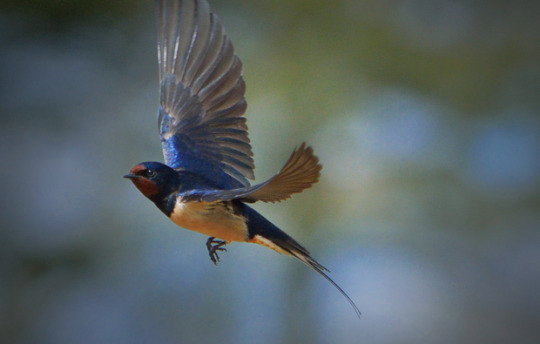
As summer gives way to autumn, birds such as swallows leave the UK for Africa Getty
September is the perfect time to watch migrant birds depart. Popular species such as swallows and house martins begin their journey south, seeking the warmer weather in Africa. Other birds, like puffins and gannets, leave our shores to spend the winter in the sea.
Islands and coastal areas are the best places to watch migratory birds, with the Isles of Scilly famous for their brilliant vantage points for spotting rare birds from North America, Europe or Asia that have been blown off-course by bad weather. It is particularly important to choose the right time of day – early morning and dusk often guarantee the best chance of spotting the birds.
This month the UK also welcomes species that spend the winter in the UK, enjoying the milder weather. Fieldfares, redwings and many kinds of ducks and geese will arrive on our shores. Wetlands are excellent spots to witness the return of thousands of geese and wading birds.
Migrating geese

Barnacle geese arrive from Greenland and Svalbard Getty
Although they began arriving in September, the size of wintering geese flocks peak in the the depths of autumn. Geese including Canada, Barnacle and Greylag will continue to arrive in vast numbers as they stop off in Britain to feed on their journey from the Arctic Circle. Expect to see impeccable V-shaped formations flapping across the skyline in one of nature’s most intriguing displays. Areas on the west coast are most likely to see the greatest numbers of arrivals, but there are a huge number of potential roosting spots dotted around the UK, including wetlands and nature reserves.
Deer rut
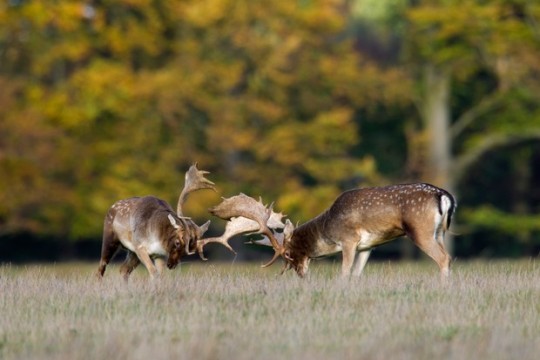
Two fallow deer bucks fighting in grassland during the rutting season in autumn Getty
The annual deer rut is iconic of autumn. A steely sky provides the backdrop for an awe inspiring and violent contest that sees stags lock antlers in battle. Because does are only in their fertile stage for about a day each year competition is ferocious. The rut is a truly tremendous display of power from Britain’s most majestic creature and is certainly one of the highlights on nature’s calendar. Some of the best places to view such a spectacle are the Inner Hebrides, the Isle of Arran, Exmoor, Dartmoor and the New Forest. Watch from a safe distance and be careful not to disturb deer during the rutting season.
Mushroom explosion
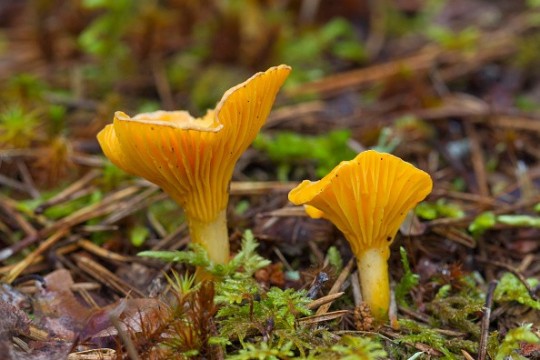
Chanterelle (Cantharellus cibarius) edible mushrooms on the forest floor in autumn woodland Getty
An unassuming but charming spectacle is to be found under your feet this autumn. From September a glut of fungi began to populate forest floors, trees, meadows and fields. This makes for a forager’s wonderland but also presents a brilliant sight to simply observe. A great variety of species have already sprung up so draw your eyes away from the transfixing autumnal trees and onto the ground. The iconic fly agaric is certainly one to look out for.
Giant puffballs
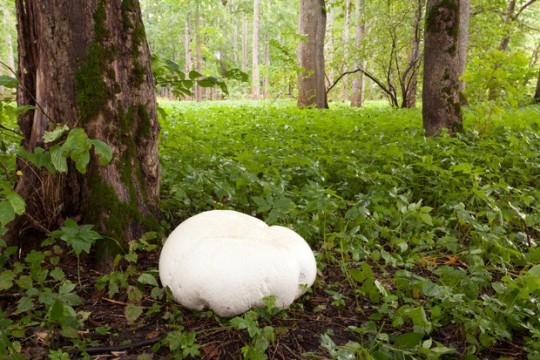
Giant puffball (Calvatia gigantea) growing in woodland Getty
The giant puffball is the largest fruitbody of any fungus and appears around this time of year, often the size of a large football or bigger. It is found in nutrient-rich grassy places such as parks, fields, roadside verges, scrub and woodland. This mushroom is edible when young and still white inside but should not be eaten after it has begun to decompose. The mushroom has also been used in bee keeping. Fumes from smoldering fruitbodies calm bees when placed beneath a hive.
Conkers
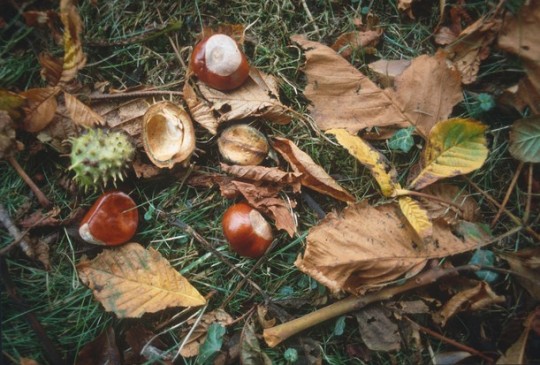
Conkers are a symbol that autumn has arrived Getty
September marks the start of conkers season and a flurry of activity on school playgrounds across the UK. The conker is the seed of the horse chestnut tree and is found in a green, hard, spiky casing. As the casing turns brown, it cracks and the conker falls out. An age-old favourite, the game of conkers involves attaching a piece of string through a hole in the conker and then swinging your conker with the aim of hitting, and eventually destroying your opponent’s conker.
Rosehips
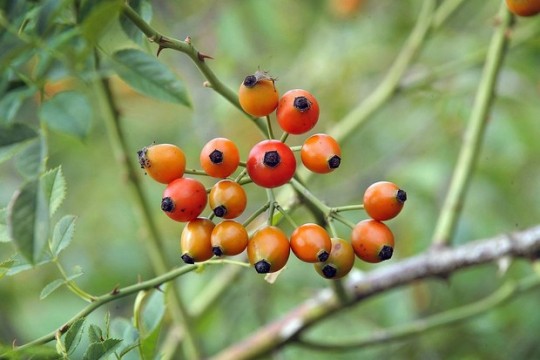
The fruit of the dog rose is known as a rosehip – it can make a delicious cordial that is also very good for you Getty
After the successful pollination of rose plants in spring and early summer, the fruit of the rose, the rosehip, starts to ripen in autumn. Rosehips can be eaten and are widely used to make jam and herbal teas. They are also used frequently to make rosehip oil and are particularly high in vitamin C. Rosehips can be eaten raw but care should be taken to avoid the hairs inside the fruit. It has been claimed by some scientists and well-known actor Larry Lamb that rosehip is a brilliant pain relief for those suffering from arthritis or joint pain.
Goldfinches feeding on seed heads
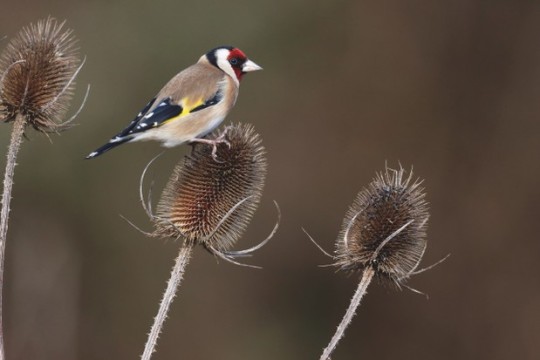
Goldfinch, Carduelis carduelis, looking for food on a autumn teasel Alamy
Keen gardeners should avoid cutting off the seed heads of plants in the autumn, as some species, including goldfinches, love to feed on them. September provides lots of seed heads for goldfinches, allowing them a broad diet of groundsels, ragworts, dandelions and more. Male goldfinches are the only birds that are able to extract seeds from teasel heads, clinging to the stem and tearing into the seed head with their long, pointed beaks. Female goldfinches have shorter beaks and so are unable, like their male counterparts, to exploit the teasel heads.
Barking muntjac deer
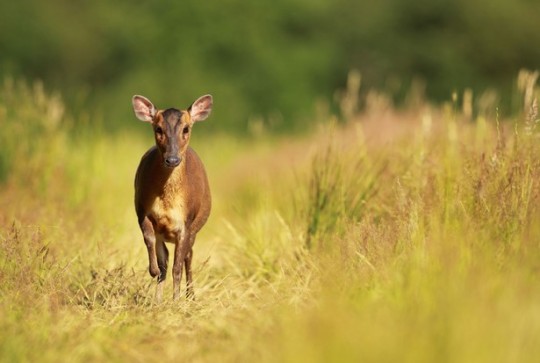
Woof, woof! Listen out for Muntjac deer this autumn Getty
Also known as barking deer, September is the perfect time to listen out for muntjac deer and their loud, characteristic bark. With a large population reaching almost every English county, and even a few in Scotland and Ireland, most people could spot, or at least hear, a muntjac deer relatively easily. Numerous circumstances lead to the distinctive bark, and other sounds include screaming by alarmed deer and squeaking by maternal does and kids. Their preferred habitat is woodland, but muntjac deer have increasingly been spotted in urban areas.
Blackberries

Autumn is still a good time to look for late-fruiting blackberries Alamy
August and September are the best months to pick blackberries. Legend has it that after the end of September, the devil spoils the blackberries after a blackberry bush broke his fall from heaven. This may be a legend but it holds good advice – as the weather gets colder, the blackberries are not as good to eat. Remember to pick carefully, avoiding the lowest berries as foraging animals may have spoiled these. Jams and crumbles are the most popular uses for blackberries, but try making blackberry sorbet or blackberry wine this September. The berries can also be frozen for use at a later date.
https://www.countryfile.com/wildlife/britains-best-autumn-wildlife-spectacles/
Thank you😊❤️❤️❤️❤️
10 notes
·
View notes
Video
instagram
Sea birds over some very rough seas recently. It's awesome watching them manage the waves perfectly. #birds #coast #wildlife #anglesey #wales #storm #britishwildlife #britishwildlifephotography https://www.instagram.com/p/B87LWnmB0WS/?igshid=8uwqi776pld2
4 notes
·
View notes
Photo



When I see the works of the British naturalist artist Charles Tanicliffe (1901-1979), who spent most of his life on the island of Anglesey in harmony with the world around him and drew scenes from the life of birds and animals, I certainly remember the 1954 Soviet cartoon "Orange Neck" based on Vitaly's story Bianki about polite partridges who wish each other a good day, are friends with a lark, follow the changes in nature around, help out relatives in trouble, sneer and philosophize: "Children, with the formation of a young partridge will not disappear anywhere!" I advise you to watch the Soyuzmultfilm masterpiece in the old voice acting, where birds speak with the voices of the great Soviet actors Maria Babanova, Georgy Vitsin, Irina Gosheva and Valentina Telegin. But the 2001 re-voice, although with the participation of Konkin, is considered not so outstanding
1 note
·
View note
Photo

A lot of my artworks are inspired by animals, and my focus is generally bulls and bison. But last summer I met a new subject – Bobby the seagull. I met bobby whilst I was braving the 400 steps to the lighthouse in South Stack, Anglesey, North Wales. The coastal views are amazing. Clear turquoise and blue waters crash against the rocks, and in the centre of it all stands this historic lighthouse (built in 1809). It was a beautiful sunny day and he followed us the entire way, watching inquisitively as we stopped to take photos. By the time we reached the lighthouse we had become quite familiar with our curious friend, now nicknamed “Bobby.” He stopped to pose for photos, flew away and then came back for more photos. I created two paintings inspired by our meeting – The diptychs “Bobby The Seagull” and “Bobby The Seagull Returns”. Both are 24 x 12 inch acrylic on canvas impressionist paintings. Bobby has been exhibited at: Contemporary Art Fair Newbury (10th – 12th May 2019) Contemporary Art Fair Windsor (8th – 10th Nov 2019) Chester Art Fair (15th – 17th Nov 2019) I also painted two more pieces inspired by the incredible views at South Stack. The first is a 16 x 16 inch acrylic on canvas, showing the lighthouse in the distance overlooking the sea. The second painting is 30 x 30 inch acrylic on canvas, and looks down onto the coastline from above. I can’t wait to continue exploring the beaches around North Wales and North West England, as soon as the weather gets better. I plan on doing a whole series on seascapes over the next few years. #anglesea #southstack #northwalescoast #northwalestagram #northwalesinstagram #seascape #seascapepainting #seascapes #coast #wales #birds #seabirds #painting🎨 #paintingofinstagram #nature #naturelover (at South Stack) https://www.instagram.com/p/B7lo6lRHbxd/?igshid=j7ax9m12yf2e
#anglesea#southstack#northwalescoast#northwalestagram#northwalesinstagram#seascape#seascapepainting#seascapes#coast#wales#birds#seabirds#painting🎨#paintingofinstagram#nature#naturelover
0 notes
Photo





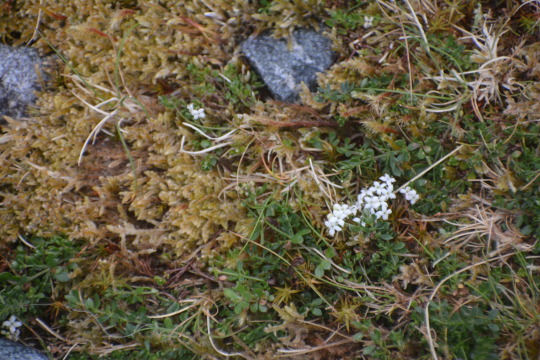



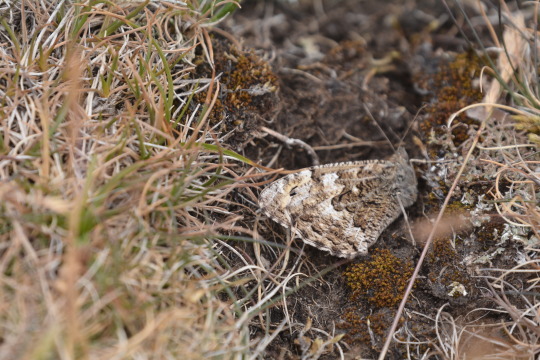
16/06/2023-Great Orme and Llandudno for a trip on the cable cars, Llanberis for a trip up Yr Wyddfa on the Snowdon Mountain railway and Llanbadrig to look at Ynys Badrig aka Middle Mouse
Pictures taken in this set: 1. Viper’s-bugloss at Great Orme in a garden area which was pretty to see. 2. Beautiful panoramic view from the Great Orme. It was so good to enjoy and be immersed in this on the cable cars you can see for miles including back down to Puffin Island where we were the other day. 3. Ravens on the Great Orme. 4 and 5. Views at Yr Wyddfa, wonderful to have this consuming and stunning experience taking in the breathtaking mountainous views again. It was special. 6. Heath bedstraw it was nice to see at Yr Wyddfa. 7 and 8. More sensational views of the sun going down over the water at Llanbadrig, it was so peaceful to be here in the evening late in the holiday a great pretty spot with the church too. 9. Chough at Great Orme, this species that has been one of our birds of the holiday was something of a surprise for us here, it was exceptional to hear their charming calls once more and see a couple. The one in the photo possibly a youngster too. 10. A Common Grayling at the Great Orme that I was astounded to see, my first of the year and this is by far the earliest sighting I’ve ever got of one the first time I’ve seen the species in June in fact. This is a species I don’t even think of until July on the New Forest heaths at home. It was brilliant to watch a few of these camouflage artists flitting through the grass, a euphoric moment to see my 32nd butterfly species of the year. Thanks to me being reminded of their sub-species something I read about before by someone I know on Twitter it seems the early sighting could be explained by them being the Hipparchia semele subspecies which is found only on the Orme as they do emerge sooner. This is pretty cool if so.
Other highlights at the Great Orme were Small Heath, Meadow Brown, Meadow Pipit, Swallow and Goldfinch, with striking Wheatears seen very nicely joyous moments, Skylark, Goldfinch and Speckled Wood seen going up Yr Wyddfa. Also on the brief look at Llanbadrig looking across to Ynys Badrig tonight it was good to see of course Gannet Middle Mouse where they have historically begun nesting which I first heard about in the Iolo’s Anglesey series last year so I was thrilled to see this, Guillemot, Cormorant, Oystercatcher, Swallow, Manx Shearwater, possible Razorbill, Black Guillemot and Chough and also Sandwich Tern. It was soothing to hear the wails of the seabirds on the island, a key and beautiful sound this week. It was great to see Grey Heron on a chip shop stop at the wonderful Betws-y-Coed with Swallow seen going through Eryri again. Newt in a pond and the famous town invading during lockdown Kashmiri Goats were nice to see at the Great Orme and other plant highlights there were scarlet pimpernel, hawksbeard, common rock-rose and water lily. Foxgloves, tormentil and cotton grass in good numbers were good to see up Yr Wyddfa and thrift, sea plantain and white clover were nice to see at Llanbadrig. Lady’s bedstraw and thyme were nice to see at both Great Orme and Llanbadrig.
#chough#common grayling#photography#wales#llandudno#llanberis#great orme#llanbadrig#ynys badrig#middle mouse#yr wyddfa#eryri#goldfinch#wheatear#raven#small heath#outdoors#north wales#europe#uk#earth#happy#sheep#lady's-bedstraw#heath bedstraw#scarlet pimpernel#2023#june#butterfly#butterflies
3 notes
·
View notes
Photo

Hidden places of perfection here in Wales. Stood here, watched the fish, listened to the birds and breathed the air. #anglesey #ynysmon #coast #timetobreathe https://www.instagram.com/p/ByQeDVNA5hH/?igshid=1j9ajz7rjp6cp
0 notes
Text
Walks along the Anglesey coastal path
Walks along the Anglesey coastal path
Winter is a time for hibernation, warm soups and log fires. The winter months roll in unforgiving and hard on Anglesey, and with it, gale force winds, driving rain and grey skies. The swell picks up and drives massive waves onshore lashing the Anglesey coast. The beaches are empty except for the dawn paw patrol walkers that we see. All with their wellington boots, rain jackets and their winter…
View On WordPress
#Anglesey coast#bass#bass fishing#beach#beach art#Beach walks#beachglass#berddgelert#biking#bird watching#bird watching anglesey#boat#bouldering#Caernarfon#Camoing#campervans#campfire#camping#camping anglesey#camping llyn#Camping Llyn Peninsula#Camping north wales#camping snowdonia#Carneddau#castles#celtic#chip shops anglesey#Christmas in north wlaes#Christmas jumpers#clean
1 note
·
View note
Text
The Sound of Silence...
The Sound of Silence…
Hey folks. Long time no speak. I said a long time ago that my blog posts were generally quite erratic! And every time I think of writing a post, I end up NOT doing it, without fail. So today there will be no fail!
First, a little rant to get it out of the way, followed by pleasant things, photography and a few videos.
Whilst the majority of the UK & the world seem to be sucked in to the current…
View On WordPress
#Anglesey#Anglesey Coastal Path#bird watching#birds#Blog#coastal photography#country walking#Hill Walking#Isle of Anglesey#Landscape Photography#North Wales#North West Wales#outdoor photography#outdoors#photography#Recreation#seascapes#VLOG#Wales#Wales Coastal Path#walking#Ynys Mon
0 notes
Text
I have moved into my own flat now. It’s as good as I expected it to be. I can finally relax properly after a day’s work, rather than still being slightly stressed out by the presence of my family members. My family members are, by far, the least stress-inducing people to interact with in my life but they still induce a nonzero amount of stress. It’s good to spend time alone.
(Maybe my feelings will change eventually, but at this point, besides all the practical problems to do with finding somebody willing, I can’t even imagine how I could possibly enjoy living with a significant other. At the moment, I think I’d be happy with this sort of living situation indefinitely.)
Work is still a drag, of course, and it remains to be seen whether I will be happy enough with the range of amenities outside the house available in this location. At the moment I’m pretty shut-in and I just spend my free time reading about maths.
Increasingly, I have been wondering whether I should try to aim to go back to university to study maths... I don’t really know how postgraduate mathematics works yet; I don’t know what level of funding is realistically expectable, for example. But I’m really enjoying studying maths at the moment. And I just read the new AMS Living Proof book, which has given me more confidence that a mathematical career is realistically achievable for me, even with my relatively mediocre talent and lack of privilege.
Judging by what I see as I walk to work and back, Atherton is a pretty nice place; I pass by pleasant green lawns and see sparrows and swifts flying about, children playing in the street, etc...
I haven’t been on the Internet very much. Partly due to absorption into studying maths. Partly due to the fact that I have a TV in the house, and it turns out that when I can watch what I want to watch (documentaries, game shows and music, none of those dull and incomprehensible Serious Dramas that most people apparently like) I really enjoy watching the TV. It provides a sort of side activity for me to partition off some of my attention to, while keeping the majority of my attention focussed on maths or whatever else, so that I’m not just obsessing over one thing all day, there’s still some intellectual variety. I guess previously taking occasional breaks to check social media websites, blogs, etc. served this role; now that I have something else in its place, I don’t really ever feel like checking Tumblr any more.
(I do still spend a lot of time checking stuff on the Internet at work, since I can’t watch TV there. That’s why I’ve been more active on Twitter and Instagram lately, since going on Tumblr at work would be embarassing [and obviously I wouldn’t want my coworkers or boss to see all the complaining I do, although IME nobody IRL is ever interested in actually looking at my social media presence, even when I make no secret about it, or if they do look they don’t reveal that they know anything about me that they wouldn’t know otherwise])
Oh, and I was on holiday last week in Anglesey, which was nice. Most excitingly, I saw a seal carcass washed up on the shore! You could see its exposed skull and everything! I also saw some living seals, as well as stonechats and black guillemots, two bird species I hadn’t seen before, plus rooks, oystercatchers, razorbills and puffins, which are always a pleasure to see...
So, that’s the latest update. There may not be another one here for a while.
0 notes